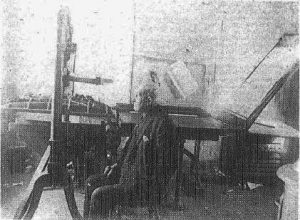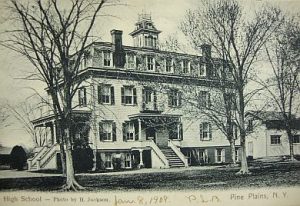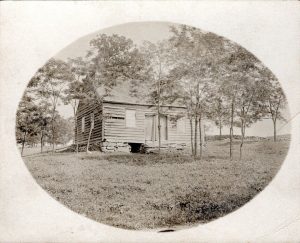This page will give a little background on some notable buildings in Pine Plains that have met an untimely demise. Like most communities, Pine Plains has seen its share of the loss of historic structures, much of it through neglect or fire. While some loss is unavoidable, the historical society feels that when a community loses this connection to its past, it loses a part of its identity.
In a few cases, portions of these structures are still with us, having been used in construction elsewhere in the town. Rural communities like Pine Plains were ever mindful of using the materials at hand, which would be considered an environmentally sound practice today but at the time was mostly out of necessity.
Historic preservation is primarily a 20th century concept, and community support is a critical component. Fortunately, Pine Plains is currently writing a comprehensive demolition law. Part of this process will be to document buildings and designate those of historic or architectural importance to the town with the hope of preserving them.
Gone Forever
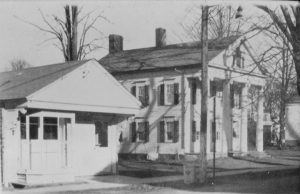
The Davis House (1834-1963)
This was an imposing Greek Revival with a beautiful spiral staircase that stood in the Pine Plains hamlet where Peck's Market parking lot is now. It was built by Dr. Jacob Davis (ca. 1796-1851). Jacob’s son Fred was the 1st European representative of the Singer Sewing Machine Company.
Around 1848 Dr. Davis caught tuberculosis after performing an autopsy on someone who had died from the disease. He had an open wound on his hand and the bacterium entered his body through this cut. Within three years he was dead. In those days, nobody knew that you could catch tuberculosis this way, especially from a corpse.
The house was occupied for many years by his daughter Anna Davis (1847-1931), who never married. It remained in the Davis family until 1944. Later, the house was used for apartments.
Anthony Matragrano (1909-1997), who owned the pharmacy on the corner (Pine Plains Pharmacy today), purchased the house and later sold it to Ellsworth W. Decker of Utica for a proposed new Grand Union grocery store and parking lot. In 1963 the house was torn down and the Grand Union was built. The uproar from the community that resulted led directly to the formation of the Little Nine Partners Historical Society. One of the most maddening things about this house's destruction is that after only about 20 years, Grand Union was gone.
In the early 1980s, William M. Peck & Son moved into this location from South Main Street, and it is now Peck’s Market (see "People" page for more on the Pecks).
The Old Pine Plains Herald Print Shop (ca. 1840-1963)
Located next to the Davis House, this little building is thought to have originally been part of the right-of-way to the Graham-Brush House and had many uses over time.
On the 1876 map it shows Mrs. Brush living here. She was the widow of Alfred Brush, the tailor, who died in 1872. The Brushes had lived in the Graham-Brush House behind it (hence the name given to the house) and Alfred Brush may have used this small building as a shop (see "Churches" and "The Graham-Brush House" pages for more on Alfred Brush and his house).
In the late 1800s it was the location of Cole's Drug Store and the Pine Plains Free Library, both under Clarissa Cole (see "People" page).
The Pine Plains Herald Print Shop, under publisher Samuel Hoag, moved here in 1911 from Bowman’s Opera House and remained here until the newspaper combined with the Pine Plains Register in 1926 (see "People" and "Fun Facts About Pine Plains" pages for more on Samuel Hoag and Pine Plains newspapers). The last occupant was the local office for the area nurse of the Dutchess County Health Association. It was torn down in 1963 at the same time as the Davis House to make way for the new Grand Union.
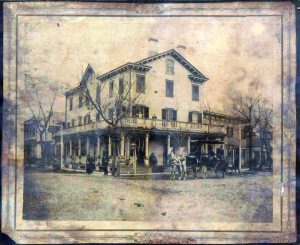
The Ketterer Hotel/Piester Building (1804-1974)
The first establishment on the southeast corner of Church and Main Streets was a log tavern built in 1798 with Dr. Asahel Haskins (see "People" page) as proprietor. The property covered 3 acres, extending east on Church Street to what later became the Peter Wolven dwelling and south on Main Street to where the Eno Law Office was built.
In 1804 father and son Ebenezer and Fyler Dibblee (see "People" page) bought the property and built a 2-story hotel on the corner. In its early years horse racing was big in Pine Plains; there was a racetrack here, and members of the “horsey set” frequently stayed at the hotel. There was also a café here which was at one time called “The Grief Hole” and policed by a bull dog. On December 30, 1820 a meeting was held here to appoint the delegates to revise the state constitution.

Under different proprietors, the hotel had many different names. In 1872, Charles Ketterer, a German immigrant and Civil War veteran, purchased the property and it remained in the family for 42 years, his son DeWitt (D.C.) Ketterer taking over after his father died. The Ketterer Hotel, under the proprietorship of father and son (see "People" and "Pine Plains Went to War" pages), another story and an addition on the south end was added to the hotel and it grew to include a bar, dining room, oyster saloon, barber shop, variety store, and a passageway was installed to the building next door which housed a pool room. During the heyday of the railroads, the trains would bring salesmen to Pine Plains every Wednesday and they would meet at the Ketterer Hotel and trade stories. This is where German lager was introduced to Pine Plains by Charles Ketterer. It was a very busy corner.

In 1889, Jay Jackson (see "People" page) moved his jewelry store into the south addition which had been the hotel's dining room (see inset).
In 1917 the building was sold and reopened as a “temperance house" (although it is said that Pine Plains was a "wet" town). Through most of the 20th century the building was rented to many other businesses while essentially still a hotel and bar.
In 1921 it was bought by Mark Piester (see "People" page), a carpenter. During his 45-year proprietorship, it was known as the Piester Building. Piester added a garage and ice cream parlor to the hotel and bar business. A typhoid epidemic in Pine Plains was blamed on Piester’s ice cream, although it was never proven. Harold King ran the bar, called "King's", the last few years under Piester.
After Piester died in 1966, the building sat vacant for several years while the town mulled buying it, and it gradually deteriorated and became a safety issue.
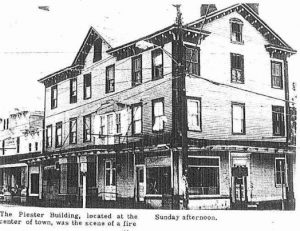
Sol Aronowitz of New York finally purchased the building. He replaced the leaky roof but didn’t follow through with a planned restoration. A small fire in 1973 created a sense of urgency in the town to do something. An agreement was struck with Aronowitz, and the building was torn down in 1974, which seemed to be what everyone wanted by that point. This is currently the location of the Town Park.
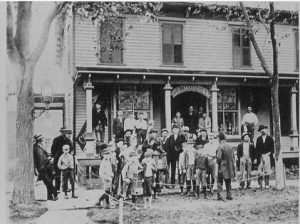
Ebenezer Dibblee, who had built what would later become the Ketterer Hotel, had the first recorded store here on the northeast corner of Main and Church Streets. It was a succession of shops under different owners, and then in 1862 it was bought by Ezra Pells who operated a drug store here, and it was known as the Pells Building. In 1882, Charles (C. L.) Morgan bought it. Morgan's Store was a restaurant and candy shop and it was known by this name for many years. At some point, the building was significantly enlarged. In 1895, the first meeting of Pine Plains Grange #803 was held in Morgan’s Store. During the 1940s it became Thompson's Store, and then later Berlin's Department Store, the last business here. In 1974, the building was torn down to allow for a west wing expansion of the Stissing National Bank which was next door (the building on the other side of the bank, which had also been a drug store at one time, had been purchased in 1957 and in 1962 had been incorporated into a new east wing for the bank, but no visible trace of it is left).
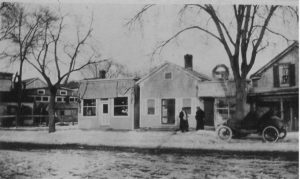 Row of Shops/Stissing Deli (before 1900-1992)
Row of Shops/Stissing Deli (before 1900-1992)
The building left of center in the photo is where the insurance agency is today on South Main Street (so obviously still standing, if a little altered), but the row of buildings to the right of it, which were actually three connected buildings, are gone. While not of particular historical or architectural significance, they warrant mention for their contributions to the life of the hamlet.
Perhaps the three buildings were always connected. The one on the north (immediate right of today's insurance agency in photo) hosted a succession of butchers: probably the longest in operation were Wolven’s Meat Market (owned by Peter S. Wolven from 1877 - 1914) and Roberts’ Meat Market (owned by Guy Roberts ca. 1920s – 1930s). Peter Wolven (see "People" page) laid the first flagstone sidewalks in Pine Plains. Guy Roberts (1893-1977), a son of Frank Roberts who owned Roberts' Funeral Home in Pine Plains (see "People" page), also owned a department store for awhile in the hamlet; he married the former Ethel Baker.
The middle building was a shoe repair shop for many years. Perhaps the longest in business was Peppe’s Shoe Repair, owned by Arcangelo Peppe (1885-1966) for about 46 years (closed 1963). Peppe and his wife, the former Esterina Proia, were born in Italy. The building on the south (far right, partial view) was a dwelling for at least part of its existence.
In about 1973 John Steckler opened the first Stissing Deli & Bakery here. In 1980 the business was taken over by Bill Boyles (1941-2016). During the ownership of Bill and his wife, the former Bonnie Schindler, the soda fountain from the drug store was moved into the south building which became an old-fashioned ice cream parlor. Bill and Marion Dodge (1933-1996), then-manager of Stissing Insurance Center next door, were instrumental in starting the Town Decorating Day tradition in 1985, which is still held the Saturday after Thanksgiving.
The business was bought by the O’Keefe family in 1988. In 1992 the buildings burned down. Lost also were murals of Pine Plains’ history painted on the inside walls by the late Millbrook artist, Peter Wing. This is an empty lot to this day.
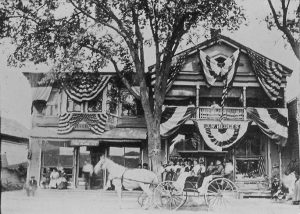
J.W. Hedges Store/Pine Plains Country Store/Post Office (ca. 1840-1981)
This building was located on South Main Street immediately south of the row of buildings just discussed. Canfield Smith owned the original store on this spot. That building was destroyed by fire prior to 1840.
A new building was built around 1840 by Henry C. Meyers (see "People" page), who also owned what was then called Meyers Hotel (Stissing House). Like the row of buildings next door, this building seems to have actually been two connected buildings. The first proprietor in the new building was Lewis D. Hedges (1815-1859), a long-time merchant (no known relation to J. W. Hedges), married to the former Mary Pulver (1822-1913), who was the daughter of one proprietor of the Stissing House, Andrus Pulver, and later step-daughter of another, Henry C. Meyers.
In 1880, the store was taken over by Underwood and Frost, sons-in-law of William S. Eno (see "People" page), who had become the owner of the property. Under their proprietorship the store was significantly expanded, making it one of the largest country stores in this part of the state at that time.
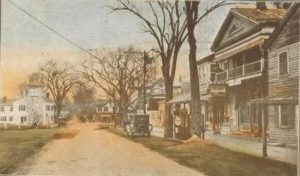
In 1901 it became Hedge's Store when J.W. Hedges (see "People" page) moved his department store into the south section. It was said he had the most complete inventory of hardware around. In 1921, Hedges installed a 5-gallon Standard Oil electric gas pump on the curb. After Hedges became postmaster, he moved the Pine Plains Post Office into the north section, where it remained until 1981.
In 1955 the Pine Plains Country Store opened in this location and operated under the same owners, Georgianna Sherman and her son Dave Sherman, for the next 25 years.
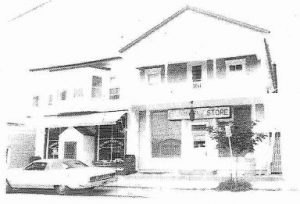
The building burned down in 1981, just as its predecessor had.
Seymour Smith Institute/Academy (1877-1932)
By the early 20th century, the small, rural school districts of the 19th century were outdated and centralization was the new model being pushed by the state. Seymour Smith Academy could no longer physically support the number of students in the school district and had deteriorated to a point where it had to be condemned. So when Pine Plains voted to centralize its school districts, the 55-year old building was torn down to make way for a new, larger school for K-12 grades, which is still standing. The demolition of this historic building was a truly sad occasion, having been such a big part of the community for so long, but sometimes we are left with no choice. At least in this case it was being replaced by another school. By using the academy site, the school district saved about $20,000 and was able to take advantage of existing sidewalks and landscaping which had once received a state prize for its natural beauty. As Board of Education president Samuel Deuel said at the dedication ceremony, "...if it had not been for the Seymour Smith Academy, we would not have had these beautiful school grounds."
(see "Seymour Smith Academy" page)
Harris Scythe Works (ca. 1810- ca. 1864) and Husted Tannery (1796-ca. 1900)
It is unfortunate that the sites of these two industries that were so important to the early history of Pine Plains are no more, but it seems to be a common fate with factories that have closed. In this case, the industries became obsolete. According to Huntting, 28,000 bricks from the scythe works shop were sold in 1879, with 15,000 of them being used in a dwelling being constructed in Pine Plains and the rest in various chimneys and other uses around town. Stone from the scythe works made its way into the foundation of the addition to the Presbyterian church, and also as foundation stone for monuments in Evergreen Cemetery. The tannery closed in the 1880s and was used for some time as a cooperage, and then was finally torn down around 1900.
(see "Industries Along the Shekomeko" page)
Bethel churches and houses
The hamlet of Bethel is the original settlement of Pine Plains and can lay claim to being a significant part of the town's early history, so it is particularly sad that many of the old buildings here are no more.
The Moravian mission and Native American village of Shekomeko were probably the first to go in the mid-1740s, after the Moravians and many of the Native Americans left and the white settlers moved into the area. These buildings were not built to be permanent structures so it is not surprising that once they were abandoned the area soon returned to its natural state. In fact, it was so well hidden by time that people even forgot what had happened here. The burial site of missionary Gottlieb Büttner was rediscovered in 1859 by The Rev. Sheldon Davis, after a curious stone with unusual engravings that had been found wedged in a local farmer's stone wall was determined to be a portion of Büttner's headstone in its original German. The monument at the corner of Strever Farm and Bethel Cross roads ensures that we will not forget again.
Old Round Top (1746-ca. 1780) was apparently poorly constructed and so it was torn down and a second Round Top (1780-1827) was built on the same site. The second church was torn down because of dwindling membership and its timber sold at auction. The next church on this spot was the Bethel Union Church (1838-ca. 1915) which suffered from a similar fate as its predecessors. After no longer being used as a church, it found a temporary second life as a social center for the farm workers from Briarcliff Farms before it, too, met its demise.
After the decline of the Quaker society in Bethel, the Quaker Meeting House (1806-1919) was abandoned. The property was sold to Phoenix Deuel in 1875, and the meeting house was torn down when the Pine Plains - Amenia Road was straightened. The Charles Hoag House (ca. 1799-2018), which was the location of a Quaker boarding school where renowned Quaker educators Jacob and Deborah Willett taught, was torn down to remove it from the tax rolls, a common but unfortunate practice these days. It is not known how much of the original boarding school was still there, since according to Huntting the girl's portion had been split off and moved sometime after 1824 to form a dwelling in Bethel, and another part later split off to form another dwelling in Bethel.
A couple of the Deuel farmhouses have also been torn down. The first to meet its demise was the Samuel Deuel homestead (ca. 1825-1918) where the large sycamore tree is on County Rte. 83. This house was dismantled by Oakleigh Thorne after he acquired Briarcliff Farms and used for wood and other materials in the main house at Briarcliff. The other house was the Phoenix Deuel homestead (? - ca. 1990s) right in the hamlet of Bethel, which seems to have been another victim of this practice of removing old houses from the tax rolls by bulldozing them rather than fixing them up. Phoenix was the postmaster of Bethel so the house served as the post office during his term, but this historic property goes back to its purchase in 1749 by John Tice Smith from an assignee of the Little Nine Partners Patent (a sale for which the historical society has the original deed).
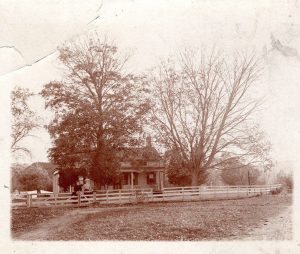
Another old house in Bethel that was torn down was the Samuel Tanner homestead (before 1867 - ca. 1964) which is where Berkshire Stud Farm is today. This property was the site of a carding mill (1815) when it was owned by Isaiah Dibble (1759-1827). Isaiah married the former Jerusha Hedges. He was one of the first subscribers to the Union Library of Pine Plains and was the grandfather of the successful merchants in the Pine Plains hamlet, Isaiah and Edward Dibble. The barns are still standing, but the farmhouse was dismantled for unknown reasons and its beautiful staircase removed to the house on Strever Farm Road, and the mantles to various other houses.
(see "Briarcliff Farms and its Successors", "Churches", "People", "The Moravian Mission at Shekomeko", and "The Hamlets" pages)
The Hunt Winans Farmhouse (ca. 1858-2019)
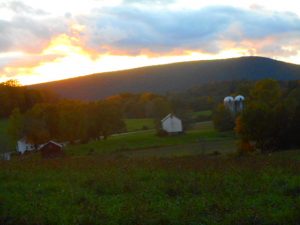 This old house was located on County Rte. 83 on a bend in the road about a mile in from Route 82. We don't know just how old it was, but it appears at least as far back as the 1858 map of Pine Plains when H.C. Meyers lived here. Henry (H.C.) Meyers was the proprietor of the Stissing House (then called Meyer's Hotel) and owned several properties in the town.
This old house was located on County Rte. 83 on a bend in the road about a mile in from Route 82. We don't know just how old it was, but it appears at least as far back as the 1858 map of Pine Plains when H.C. Meyers lived here. Henry (H.C.) Meyers was the proprietor of the Stissing House (then called Meyer's Hotel) and owned several properties in the town.
The farm later came to be known as the Hunt Winans Farm, after Huntting C. Winans, Sr., but its official name was the Winfarm Dairy Farm, which he operated for 72 years, until 1985.
In this recent photo, the house appears in the lower left. It is believed the house was demolished to remove it from the tax rolls. It happened literally overnight: one day the house was there, the next day it was gone. The farm buildings in the photo are still standing.
At Risk
Any time that a business or church closes, or a family moves away, the longer that building sits vacant the more it is at risk of being demolished. Here are a few historic buildings in our town that we consider currently at risk for those reasons.
Patchins Mill (ca. 1801) and Patchin Homestead (1812)
This old grist mill located in the hamlet it is named for, is the last of its kind in the town. It is no longer in use. See "The Hamlets" and "Industries Along the Shekomeko" pages for more information.
UPDATE: both the mill and homestead recently (2022) have been purchased by FOSL with plans for restoration. 
Deuel's Hardware Main Building, former roller skating rink (1885)
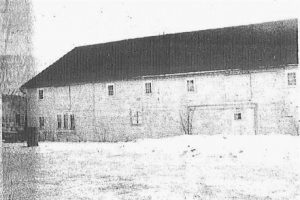
This building was originally located by the P&E RR yard. It was 50 ft. wide, 100 ft. long, and 14 ft. high, and was built to be used as a combined public hall (Stissing Hall, upstairs) and roller skating rink. Young people came here by train from all over the county, as it was one of the first skating rinks in the area. Skating cost .10 per person and that included the rental of the skates. Barrel jumping and figure skating were both popular. The rink had a special maple floor which allowed the skater to always skate along the length of the boards. In 1908, years after the rink had closed, Samuel Deuel, who had a coal and feed business nearby, purchased the building and used it for storage and as a cooperage for apple barrel making. He rented it out on occasion for public dances. In 1918-1919 he moved the building in sections to South Main Street, along with the rest of his operation. The property is currently for sale.
Success Stories
The following were all at risk at one time but were saved (or are in the process of being rescued) by one or more individuals from almost certain destruction.
Memorial Hall (1915)
This building was slated for demolition in 1968, but fortunately that never came to pass. Now The Stissing Center, a performing arts venue. See "Memorial Hall" page for information.
Stissing House (1801)
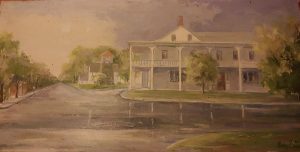
This historic and architecturally important building on the southwest corner of Church and Main Streets in the Pine Plains hamlet was built in 1801; subsequent additions up to the early 1900s resulted in six distinct sections. Originally the site of a log tavern built in 1782 by Cornelius Elmendorph, it is one of the oldest continuously operating inns in America and is a rare example of a 2-story Dutch-framed structure. It features an unusual domed-ceiling ballroom on the second floor. Known by the names of its various proprietors through much of its history, during the heyday of the railroads it was a popular place for people from New York City to spend their summer vacations. Sometime in the mid-20th century after the decline of the railroads, it ceased being an inn and became the local watering hole, and that was when it began to lose its luster. It was saved in 1991 when purchased by Dale Mitchell, soon joined by Dr. Richard Strongwater and Christian Eisenbeiss. After an extensive renovation, it reopened in 1998 as a gourmet restaurant and occasional performance and exhibition venue.
See "The Hamlets" and "People" pages for more information.
Graham-Brush House (ca. 1750)
Rescued by the Little Nine Partners Historical Society in 1997, this is one of the last remaining pre-Revolutionary log houses in the region.
See "The Graham-Brush House" and "People" pages for more information.
Harris-Husted House (ca. 1790)
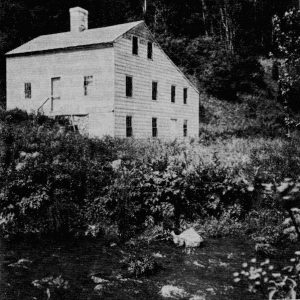 This saltbox located in the hamlet of Hammertown was rescued by the Little Nine Partners Historical Society in 1964-65, shortly after the society had been formed in response to the loss of the Davis House. It was slated for demolition when the state rerouted Route 199 and the house stood in the way. The historical society was gifted a beautiful piece of land on the Shekomeko Creek and purchased the house for $1.00 and moved it to the new location. Around 1997, the historical society sold the house to a private party so that it could purchase the Graham-Brush House.
This saltbox located in the hamlet of Hammertown was rescued by the Little Nine Partners Historical Society in 1964-65, shortly after the society had been formed in response to the loss of the Davis House. It was slated for demolition when the state rerouted Route 199 and the house stood in the way. The historical society was gifted a beautiful piece of land on the Shekomeko Creek and purchased the house for $1.00 and moved it to the new location. Around 1997, the historical society sold the house to a private party so that it could purchase the Graham-Brush House.
See "The Hamlets" for more information.
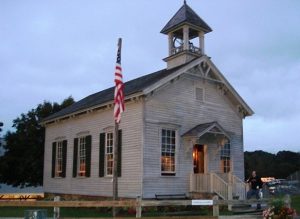
Bentley Memorial School (1881)
This lovely old schoolhouse and community building from the Mount Ross hamlet was in a serious state of decay after many years of abandonment when it was purchased by the Dutchess County Fair and moved to the fairgrounds in 2004, where it now functions as a museum.
See "The Hamlets" page for more information.
Several other former schools in Pine Plains have been saved, many converted into homes.
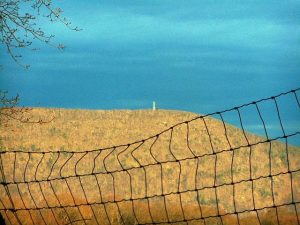
Stissing Mountain Fire Tower (1934)
When we think about buildings that have disappeared from our landscape over time or which are currently at risk, the importance of a structure such as a fire tower might be overlooked. But make no mistake about it, our fire tower on Stissing Mountain has become a symbol of Pine Plains and is as beloved by the Pine Plains community as the Stissing House or the former Memorial Hall. In fact, it is hard to imagine the view of Stissing Mountain without its iconic tower perched on top. Yet, after the fire tower had outlived its usefulness by 1973, its future was very much in doubt. When New York State announced in 1986 that it would be dismantling the tower, a group of concerned citizens formed FOSL, Friends of Stissing Landmarks, a not-for-profit organization which finally acquired the tower in 1994.
For more information, visit the FOSL website.
Baptist Church/Pine Plains Grange (1837; rebuilt after tornado in 1838)
The Baptist Church had struggled for many years until finally closing in 1932. Fortunately, it was purchased in 1935 by Pine Plains Grange #803. But then the Grange also closed around 1989. Pine Plains should consider itself lucky that this beautiful old building in the center of the hamlet has found new life with businesses that have turned it first into a long-time antique shop and now an art gallery.
See "Churches" page for more information.
Old Library (ca. 1840)
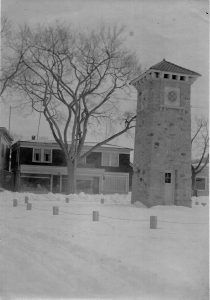
It is said that Richard Peck, who came to Pine Plains in 1840, built this building for his law office. When he was appointed the Pine Plains Postmaster in 1861, this became the Pine Plains Post Office, where it remained until about 1899.
From about 1874 - 1884 it simultaneously housed the Pine Plains Free Library. It is thought that the deputy postmaster, Henry Parker, acted as a custodian of the books for a period (the books may have been stored here in boxes while the library was closed from about 1870-1874). However, the building was mostly known during this time as the Old Post Office.
After Harry Jackson purchased the building in 1902, he made significant additions. It was known for many years afterwards as the Harry Jackson Building. It would later house shops, nurses offices, the Pine Plains Register Office, a restaurant, and apartments. In the 1960s it became known as the McGhee Building after owner Kenneth McGhee. In 1968 a capital fund allowed the purchase of the building for the library, which had been operating out of librarian Helen Netter's house. The library gifted the building to the town in 1973. This was once again the home of the Pine Plains Free Library until the present library building was opened in 2009, at which time it became known as the Old Library.
After several years standing vacant, the building has been (thankfully) purchased and is undergoing a long-overdue and highly anticipated renovation.
See "People" and "Exhibits" pages for more information.

